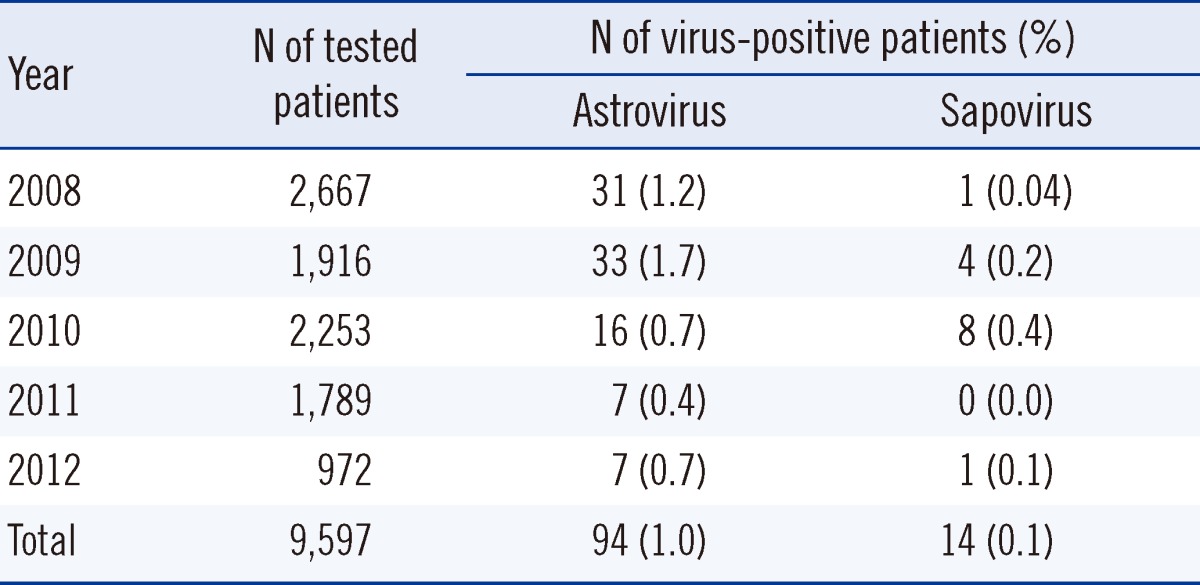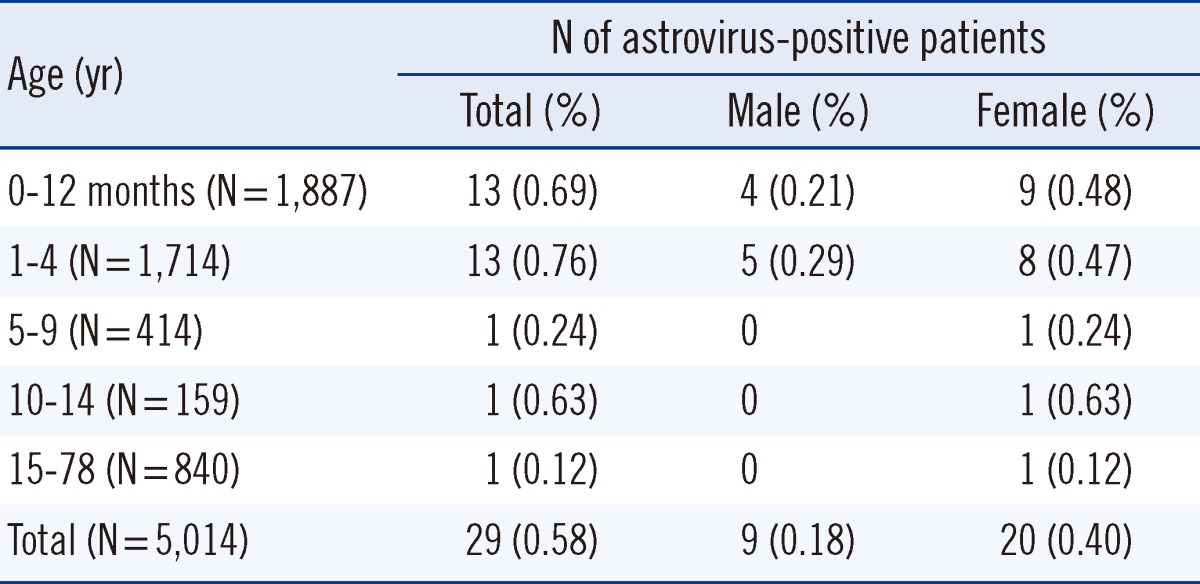Abstract
The prevalence of human astroviruses was tested in patients with acute gastroenteritis by using conventional duplex reverse transcription (RT)-PCR and electrophoresis. Diarrheal fecal samples were collected from 9,597 patients at local hospitals in Seoul. The prevalence of astroviruses was 1.0% (94/9,597 patients; mostly infants), and that of sapoviruses was 0.1% (14/9,597 patients). Age- and gender-wise analyses were carried out on 29 astrovirus-positive patients having complete information on file regarding their age, gender, and other particulars. The results were higher in patients of ages 0 to 14 yr, and 69.0% of the astrovirus-positive patients were females, of which 69.2% were infants (0 to 12 months), and 61.5% were 1-4 yr old. Notably, in the case of 5 to 78-yr-old acute gastroenteritis patients, 100% were females.
Monitoring of diarrheal patients in Korea has revealed that the incidence of bacterial infections is declining, whereas viral infections are on the rise. Gastroenteritis caused by astroviruses is becoming common, and being contagious, can be easily transmitted; however, it is clinically less severe than rotavirus and norovirus infections [1-5]. In developed countries, the prevalence of astrovirus in diarrheal children was 4-8% [6, 7]. In England, 75% of children aged 5 to 11 yr did not develop any diarrheal symptoms. In addition, 75% of adults aged 17 to 30 yr were positive for astrovirus antibodies as measured by immunofluorescence testing, indicating that they had been exposed to the virus during childhood [7]. These results indicated that astroviruses are important causative agents of acute gastroenteritis [4, 7]. Astroviruses induce acute gastroenteritis in newborns, as well as severe and chronic diarrhea in immunocompromised patients [8]. Even though the most common causative agents are noroviruses and rotaviruses, astroviruses are also capable of causing gastroenteritis [1, 5, 9]. In the present study, we investigated the prevalence of uncommon human astrovirus in patients with acute gastroenteritis.
A total of 9,597 diarrheal fecal samples from patients suffering from acute gastroenteritis were collected from six local hospitals in Seoul (SW hospital, SG hospital, AM center, NP hospital, EJ hospital, and NM center) from 2008 to 2012. These samples were tested for the presence of astrovirus and sapovirus. One gram of feces was mixed with 9 mL of autoclaved 0.1 M phosphate buffered saline (PBS; pH 7.4, Sigma, St. Louis, MO, USA) and centrifuged at 1,660 g for 30 min at 4℃. The supernatant was used for the next step of fragmentation at 4℃. At the AM center, 0.5 to 1 mL rectal swab suspensions were collected instead of feces, and mixed with PBS for further processing. Most of the samples, from either direct rectal swabs or diarrheal feces of patients, were collected from six hospitals and transferred within 24 hr to Seoul Metropolitan Research Institute of Public Health and Environment, where they were stored at -70℃ until further analysis.
For the detection of astroviruses, one-step duplex RT-PCR followed by electrophoresis was carried out. RNA was extracted by using a viral RNA mini kit (QIAgen, Hilden, Germany) [10]. One-step duplex RT-PCR was performed by using the Hotstart RT/PCR premix Astro/Sapo kit (K-2055-C, Bioneer, Daejeon, Korea) and the Mon269/Mon270 primer pair that hybridized within the open reading frame (ORF) 2 region (5'-CAACTCAGGAAACAGGGTGT-3', and 5'-TCAGATGCATTGTCATTGGT-3', respectively) [2, 6]. Positive results were indicated by the presence of a 449 bp band for astrovirus and a 720 bp band for sapovirus [2, 6].
Our analysis showed that, in diarrheal feces collected from 2008 to 2012 at local hospitals in Seoul, astroviruses were detected in 1.0% (94/9,597) and sapoviruses in 0.1% (14/9,597) of samples (Table 1).
In 2011, results from the Korea Center for Disease Control (KCDC) showed that out of 26,673 diarrheal fecal samples, 83 (0.3%), tested positive for human astrovirus, and 7 (0.0%) for sapovirus [11]. In 2002, Kang et al. [12] reported the presence of human astrovirus, by RT-PCR of the ORF-1a region, in 1.5% of samples (15/1,153 patients) collected from five tertiary hospitals, four secondary hospitals, and one primary hospital. However, other studies have shown higher positive rates for human astroviruses; 58% (7/12 patients) in a tertiary hospital (Seoul National University hospital) in 2004 [10], 4.0% (33/812 patients) in a postpartum care center in 2006 [4], and 29.5% (18/61 patients) in a tertiary hospital (Ewha Womans University hospital) in 1999 [7]. Although our results were similar to those obtained from the Korean CDC and Kang et al. [12], the numbers were lower than those reported by Lee et al. [10], Jung et al. [4], and Park et al. [7], possibly due to low sample numbers.
The detection rates of astrovirus were then analyzed year-wise, which showed a decreasing trend of 1.2% in 2008, 1.7% in 2009, 0.7% in 2010, 0.4% in 2011, and 0.7% in 2012; the exception being the year 2009 where it showed an increase (1.7%). In earlier years, the astrovirus-positive rates showed an initial increase of 1.5% (15/1,153 patients) in 2002 [12], 3.8% in 2004 [6], and human astrovirus positive rate 4.0% (33/812 patients) in 2006 in a tertiary hospital (Sangge Bak hospital) [3]. Subsequently, the rates showed a decrease of 4.0% (73/1,836 patients) in 2004, 3.5% (47/1,338 patients) in 2005, 1.6% (36/2,213 patients) in 2006, 0.6% (8/1,401 patients) in 2007 [10], and 0.3% (83/26,673 patients) in 2011 [11]. From the above observations, it can be concluded that the prevalence of astroviruses in patients with gastroenteritis is declining every year.
In subsequent studies, the prevalence of astrovirus-positive samples was analyzed on a monthly basis over a five-year period. The numbers of astrovirus-positive samples from January to December were equalized (11, 9, 13, 9, 5, 7, 3, 6, 8, 8, 12, and 3 over the 12-month period) and showed no significant difference between all the five years tested (Fig. 1). However, an interesting trend reported in another study stated that the detection of astroviruses was higher in May, June, July, and August than in December, January, and February [6].
Next, age- and gender-wise analyses were carried out on 29 astrovirus-positive patients having complete information on their age, gender, and other particulars. As expected, astroviruses were commonly detected in infants, especially in newborns. Out of 29 (0.58%) astrovirus-positive patients, 0.69% (13/1,887 patients) were 0 to 12-month-old infants, 0.76% (13/1,714 patients) were 1 to 4 yr old, 0.24% (1/414 patients) were 5 to 9 yr old, 0.63% (1/159 patients) were 10 to 14 yr old, and 0.12% (1/840 patients) were 15 to 78 yr old. The detection of astroviruses was higher in patients aged 0 to 14 yr, and subsequently decreased in older individuals (Table 2). Jung et al. [3] reported 82.0% (27/33 patients) of positive rate in children below 12 months old, of which newborns constituted 39.4% (13/33 patients), at the Sangge Bak tertiary hospital; whereas Lee et al. [6] reported astrovirus-positive rates of 8.4% (48/572 patients) in children below 12 months old. Our results were comparable to those from the above two studies as well as to results from a tertiary hospital (Seoul National University hospital) where the average age of astrovirus-positive children was 20.6±15.4 months [9]. From the above analyses, it can be concluded that astroviruses are important pathogens associated with acute gastroenteritis in infants, especially below 2 yr [3-5]. All feces and rectal swabs were obtained from outpatients at six hospitals, of which one was a primary hospital (AM center), three were secondary hospitals (SW hospital, NP hospital, and NM center), and two were tertiary hospitals (SG and EJ hospitals).
Finally, gender-based analyses were carried out on 20 female and 9 male patients. The results showed that 69.0% of the astrovirus-positive patients were females, of which 69.2% were infants (0 to 12 months), and 61.5% were 1-4 yr old. Notably, 5 to 78-yr-old patients with acute gastroenteritis were all females.
In conclusion, astroviruses were prevalent in the patients with gastroenteritis, and showed a higher occurrence in young children and female patients compared to the general population.
Acknowledgment
This study was supported by the EnterNet-Korea Project of the Korean CDC. We are grateful for this support.
References
1. Lee JI. Molecular characterization of enteric viruses isolated from acute gastroenteritis patients. Chung Buk University;2008. Ph.D. Thesis.
2. Park SH, Kim EJ, Oh SA, Kim CK, Choi SS, Cho SJ, et al. Viral agents associated with acute gastroenteritis in Seoul, Korea. Clin Lab. 2011; 57:59–65. PMID: 21391466.
3. Chung JY, Huh K, Kim SW, Shin BM, Han TH, Lee JI, et al. Molecular epidemiology of human astrovirus infection in hospitalized children with acute gastroenteritis. Korean J Pediatr Gastroenterol Nutr. 2006; 9:139–146.

4. Yi J, Lee JK, Chung EH, Cho DH, Kim EC. An outbreak of astrovirus infection of newborns with hemorrhagic diarrhea in a neonatal unit. Korean J Clin Microbiol. 2004; 7:55–58.
5. Chung JY. Acute viral gastroenteritis: recent trends and updates. Korean J Pediatr Gastroenterol Nutr. 2007; 10(S1):S53–S57.
6. Lee JI, Hwang YO, Kim SJ, Song MO, Kim JS, Seo BT, et al. Detection of astroviruses from diarrhea patients by RT-PCR and EIA. Report of SIHE. 2004; 40:290–300. Updated on Feb 2013. http://health.seoul.go.kr/healthlab/1623?sc=bd_title&pageno=1&bc_no=108&sv=astrovirus.
7. Park HK, Woo SY, Seoh JY, Chong YH, Seo JW. Detection of astrovirus infections from hospitalized young children feces by reverse transcription-polymerase chain reaction. J Korean Soc Microbiol. 1999; 34:453–459.
8. Unicomb LE, Banu NN, Azim T, Islam A, Bardhan PK, Faruque AS, et al. Astrovirus infection in association with acute, persistent and nosocomial diarrhea in Bangladesh. Pediatr Infect Dis J. 1998; 17:611–614. PMID: 9686727.

9. Yang HR, Jee YM, Ko JS, Seo JK. Detection and genotyping of viruses detected in children with benign afebrile seizures associated with acute gastroenteritis. Korean J Pediatr Gastroenterol Nutr. 2009; 12:183–193.

10. Lee JI, Park SH, Kim MS, Oh YH, Yu IS, Choi BH, et al. Surveillance of acute gastroenteritis in Seoul, Korea, during May 2004 and June 2007. J Bacteriol Virol. 2009; 39:363–371.

11. Korea Centers for Disease Control and Prevention. Enternet Korea, Yearly Report. 2012. 43–49. Updated on Nov 2013. http://www.cdc.go.kr/CDC/notice/CdcKrInfo0301.jsp?menuIds=HOME001-MNU0004-MNU0036-MNU0037&cid=21904.
12. Kang YH, Park YJ, Ahn JB, Yeun JD, Jee YM. Identification of human astrovirus infections from stool samples with diarrhea in Korea. Arch Virol. 2002; 147:1821–1827. PMID: 12209320.

13. Park KS, Baek KA, Kim DU, Kwon KS, Bing SH, Park JS, et al. Evaluation of a new immunochromatographyic assay kit for the rapid detection of norovirus in fecal specimens. Ann Lab Med. 2012; 32:79–81. PMID: 22259783.
14. Kim JS, Lim CS, Kim YK, Lee NL, Lee CK. Human bocavirus in patients with respiratory tract infection. Korean J Lab Med. 2011; 31:179–184. PMID: 21779192.





 PDF
PDF ePub
ePub Citation
Citation Print
Print





 XML Download
XML Download